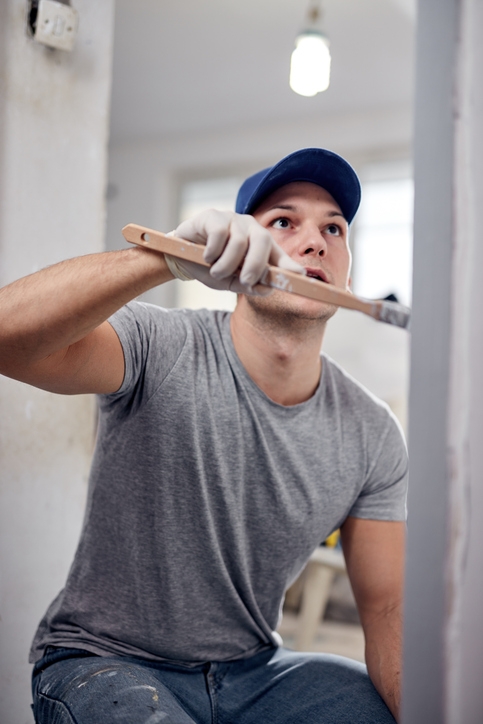Someday, you had to spruce up and update your Pleasant Hill, CA area home’s appearance with painting for certain reasons. You want to address wear and tear on surfaces or bring in new colors and designs for a revitalized feel. Repainting your home makes it more beautiful and reflects your style better.
But before dabbing a fresh coat of paint on your Orinda, CA area home’s exterior or interior surfaces, there are things that you will want to do – or even should do – before house painting. These are the keys to achieving a beautiful and long-lasting finish.
If you choose to go the “do-it-yourself” or DIY route, preparing before painting is crucial to achieving a smooth, professional finish. Here’s a step-by-step guide on what to do before applying paint:
1. Choose the right paint and tools
- Paint type: Select the appropriate type for the surface (e.g., interior, exterior, satin, semi-gloss).
- Color: Test samples on the wall to see how they look under different lighting.
- Tools: Invest in high-quality brushes, rollers, painter’s tape, a paint tray, and any necessary primer.
2. Prep the room
- Clear the area: Remove furniture and wall décor or cover them if moving is impractical.
- Protect floors and fixtures: Lay down drop cloths, cover any exposed fixtures, and use painter’s tape to cover outlets, switches, and trim.
3. Clean the surface
- Dust and wipe down walls: Remove dust, grease, or stains, especially in kitchens and bathrooms.
- Wash with a mild soap solution if walls are dirty, then rinse with clean water and let dry.
4. Repair imperfections
- Patch holes and cracks: Use spackling or joint compound for small holes and cracks. For more extensive repairs, use wall repair patches.
- Sand smooth: Sand the patched areas and any rough spots for a smooth, even surface. Wipe off sanding dust with a damp cloth.
5. Prime the surface
- Choose the correct primer: Use stain-blocking primer on stained walls and bonding primer for glossy surfaces.
- Apply evenly: Prime walls to improve paint adhesion and ensure an even topcoat, especially if painting over a dark or bright color.
6. Ventilate the area
- Open windows and use fans, if possible, to ensure proper ventilation, which helps with drying times and minimizes fumes.
7. Evaluate your technique
- Sample brush strokes: Try sample strokes or a small patch to check paint consistency and coverage.
- Confirm drying time: Follow the manufacturer’s guidelines on drying time to plan for second coats.
With good prep, your paint job will look smoother, last longer, and have a more professional finish! This also true of commercial spaces as well which often need services like custom epoxy flooring, concrete ceiling repair and more.
Why is surface preparation essential in a paint project?
Many DIY home painters in the Walnut Creek, CA area skip prep work because they see it as time-consuming, messy, and seemingly unnecessary. They dismiss prep work as unimportant, are unaware of the required steps, or don’t know how much preparation work impacts durability and appearance.
Some cite a lack of budget, as buying extra materials like primer, sandpaper, or fillers can seem like added expenses that may not seem worth it.
But they’re actually making a glaring mistake. Skipping prep work can lead to poor paint adhesion, peeling paint, visible flaws, uneven texture, and overall shoddy paint quality.
Improper or utter lack of surface preparation also means redoing the work sooner due to other problems like peeling, cracking, or fading. The cost of additional paint and labor for rework typically outweighs the initial savings.
Surface prep work is essential before painting because it:
- Ensures better paint adhesion: Clean, smooth surfaces help paint bond more effectively.
- Prevents paint defects: Properly prepared surfaces reduce peeling, bubbling, and cracking.
- Improves durability: Well-prepped surfaces lead to a longer-lasting, more resilient finish.
- Enhances aesthetic quality: Smooth surfaces provide a uniform, professional appearance.
- Saves time and money: Minimizing future repairs and touch-ups reduces long-term costs and effort.
- Promotes safety: Removing old lead-based paint, mold, or mildew makes surfaces safer and healthier.
While prep work may seem tedious, it is essential to achieve a quality, long-lasting paint job that looks good and stands the test of time. Taking the extra steps enhances the look and saves effort and money overall.
Hiring a professional painter
Do you want to hand the house painting work to a professional painter instead? It also requires preparation to ensure a smooth, successful project. Here’s a guide to help you get ready:
1. Define the scope and budget
- Room count and surfaces: Decide which rooms, walls, or exterior surfaces need painting, and specify if ceilings, trim, or doors are included.
- Paint type and finish: Consider the type of paint (e.g., low-VOC for indoor air quality) and finish (e.g., matte, satin, semi-gloss) that’s best for your needs.
- Set a budget: Factor in the cost of labor, materials, and any required repairs or preparation.
Hiring a professional painter
Preparing to hire professional painters can make a significant difference in the quality of the work and your overall satisfaction. Here are the key steps you should take:
1. Research and referrals
- Ask for referrals: Ask friends, family, or neighbors who have recently hired painters for recommendations. Word-of-mouth referrals can provide trustworthy leads.
- Online research: Look up reviews on platforms like Google, Yelp, or the Better Business Bureau (BBB) to see if there are any red flags or consistently positive feedback for particular companies.
2. Request and check references
- Contact previous clients: Reputable painters should be able to provide references. Call or email a few to ask about their experience, the professionalism of the crew, and whether the work was completed on time and within budget.
- Inspect past work: If possible, visit one or two past projects to personally see the quality of their work. Doing so can give you a good sense of their attention to detail and the durability of the finish.
3. Interview the painters
- Experience and credentials: Ask about their experience, especially with the type of painting you need (e.g., exterior, interior, or specific materials like wood or brick).
- Process and preparation: Discuss their preparation process, including how they will protect your floors, furniture, and landscaping. Inquire about cleaning, priming, and any wall or surface repairs they handle before painting.
- Products and materials: Ask about the types of paint they recommend and whether they can use low-VOC options if you have concerns about indoor air quality.
- Insurance and licensing: Ensure they’re fully insured and licensed. Liability and worker’s compensation insurance protect you from potential liabilities in case of accidents.
4. Get multiple estimates
- Detailed quotes: Request estimates from at least three different painters. Ensure each quote includes a breakdown of costs, including labor, materials, and any extra fees. A detailed quote will help you compare services accurately.
- Timeline: Get a clear sense of the start and end dates and any factors that may affect the timeline, such as weather or additional repairs.
5. Observe professionalism
- Communication: Notice how responsive and organized they are. Prompt responses and clear communication are good indicators of professionalism.
- Estimate timeliness: Being on time for meetings and delivering estimates promptly reflect well on the company’s reliability.
6. Decide based on value, not just price
- Consider the full scope of what each painter offers and make a decision based on their reputation, quality of work, and professionalism.
7. Clarify the timeline and schedule
- Availability: Schedule the painting job during a convenient time for you, factoring in drying time if you’ll be home during the project.
- Duration: Confirm how long the painters estimate each phase will take, including prep, priming, painting, and cleanup.
- Weather conditions (for exterior): For exterior painting, ensure the project is scheduled during a time when weather conditions are favorable.
8. Confirm details with the painter
- Prep work included: Make sure they plan to prime surfaces and handle caulking, sanding, or patching as needed.
- Paint brand and color choices: Verify the exact paint colors, finishes, and brands to be used.
- Payment terms and warranties: Discuss payment terms, any warranties on labor or materials, and the protocol for touch-ups or corrections after completion.
These steps will help streamline the process, avoid miscommunications, and give you a better result with less hassle.
Whether you are going to paint yourself or hand the work to a professional, it’s important to take your time so that you’ll be able to enjoy a beautiful and long-lasting paint finish for your Lafayette, CA area home.
If you have doubts and concerns, consult the professional of our team at Custom Painting, Inc. Give one of your biggest and most important investments the best care it deserves. If you live in or around Pleasant Hill, call us at 925-686-0903 or message us here for a free, no-obligation quote!



